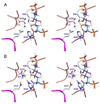Common basis for the mechanism of metallo and non-metallo KDO8P synthases
- PMID: 20825995
- PMCID: PMC2949461
- DOI: 10.1016/j.jinorgbio.2010.08.008
Common basis for the mechanism of metallo and non-metallo KDO8P synthases
Abstract
The three-dimensional structures of metal and non-metal enzymes that catalyze the same reaction are often quite different, a clear indication of convergent evolution. However, there are interesting cases in which the same scaffold supports both a metal and a non-metal catalyzed reaction. One of these is 3-deoxy-D-manno-octulosonate 8-phosphate (KDO8P) synthase (KDO8PS), a bacterial enzyme that catalyzes the synthesis of KDO8P and inorganic phosphate (P(i)) from phosphoenolpyruvate (PEP), arabinose 5-phosphate (A5P), and water. This reaction is one of the key steps in the biosynthesis of bacterial endotoxins. The evolutionary tree of KDO8PS is evenly divided between metal and non-metal forms, both having essentially identical structures. Mutagenesis and crystallographic studies suggest that one or two residues at most determine whether or not KDO8PS requires a metal for function, a clear example of "minimalist evolution". Quantum mechanical/molecular mechanical (QM/MM) simulations of both the enzymatic and non-enzymatic synthesis of KDO8P have revealed the mechanism underlying the switch between metal and non-metal dependent catalysis. The principle emerging from these studies is that this conversion is possible in KDO8PS because the metal is not involved in an activation process, but primarily contributes to orienting properly the reactants to lower the activation energy, an action easily mimicked by amino acid side-chains.
Copyright © 2010 Elsevier Inc. All rights reserved.
Figures





Similar articles
-
Structural and mechanistic changes along an engineered path from metallo to nonmetallo 3-deoxy-D-manno-octulosonate 8-phosphate synthases.Biochemistry. 2007 Apr 17;46(15):4532-44. doi: 10.1021/bi6024879. Epub 2007 Mar 24. Biochemistry. 2007. PMID: 17381075
-
The use of (E)- and (Z)-phosphoenol-3-fluoropyruvate as mechanistic probes reveals significant differences between the active sites of KDO8P and DAHP synthases.Biochemistry. 2005 May 17;44(19):7326-35. doi: 10.1021/bi047282q. Biochemistry. 2005. PMID: 15882071
-
The energy landscape of 3-deoxy-D-manno-octulosonate 8-phosphate synthase.Biochemistry. 2009 Dec 15;48(49):11706-14. doi: 10.1021/bi901341h. Biochemistry. 2009. PMID: 19891460
-
Synthesis and antibacterial activity of mechanism-based inhibitors of KDO8P synthase and DAH7P synthase.Carbohydr Res. 2005 Mar 21;340(4):529-37. doi: 10.1016/j.carres.2004.11.019. Carbohydr Res. 2005. PMID: 15721322
-
An extended β7α7 substrate-binding loop is essential for efficient catalysis by 3-deoxy-D-manno-octulosonate 8-phosphate synthase.Biochemistry. 2011 Nov 1;50(43):9318-27. doi: 10.1021/bi201231e. Epub 2011 Oct 10. Biochemistry. 2011. PMID: 21942786
Cited by
-
Structure of 2-keto-3-deoxy-D-manno-octulosonate-8-phosphate synthase from Pseudomonas aeruginosa.Acta Crystallogr Sect F Struct Biol Cryst Commun. 2013 Oct;69(Pt 10):1084-8. doi: 10.1107/S1744309113023993. Epub 2013 Sep 28. Acta Crystallogr Sect F Struct Biol Cryst Commun. 2013. PMID: 24100553 Free PMC article.
-
The contribution of coevolving residues to the stability of KDO8P synthase.PLoS One. 2011 Mar 9;6(3):e17459. doi: 10.1371/journal.pone.0017459. PLoS One. 2011. PMID: 21408011 Free PMC article.
References
-
- Lehninger AL. Physiol. Rev. 1950;30:393–429. - PubMed
-
- Cooper SJ, Leonard GA, McSweeney SM, Thompson AW, Naismith JH, Qamar S, Plater A, Berry A, Hunter WN. Structure. 1996;4:1303–1315. - PubMed
-
- Kim H, Certa U, Dobeli H, Jakob P, Hol WGJ. Biochemistry. 1998;37:4388–4396. - PubMed
-
- Gamblin SJ, Cooper B, Millar JR, Davies GJ, Littlechild JA, Watson HC. FEBS Lett. 1990;262:282–286. - PubMed
-
- Hester G, Brenner-Holzach O, Rossi FA, Struck-Donatz M, Winterhalter KH, Smit JDG, Piontek K. FEBS Lett. 1991;292:237–242. - PubMed
Publication types
MeSH terms
Substances
Grants and funding
LinkOut - more resources
Full Text Sources
Research Materials
Miscellaneous

